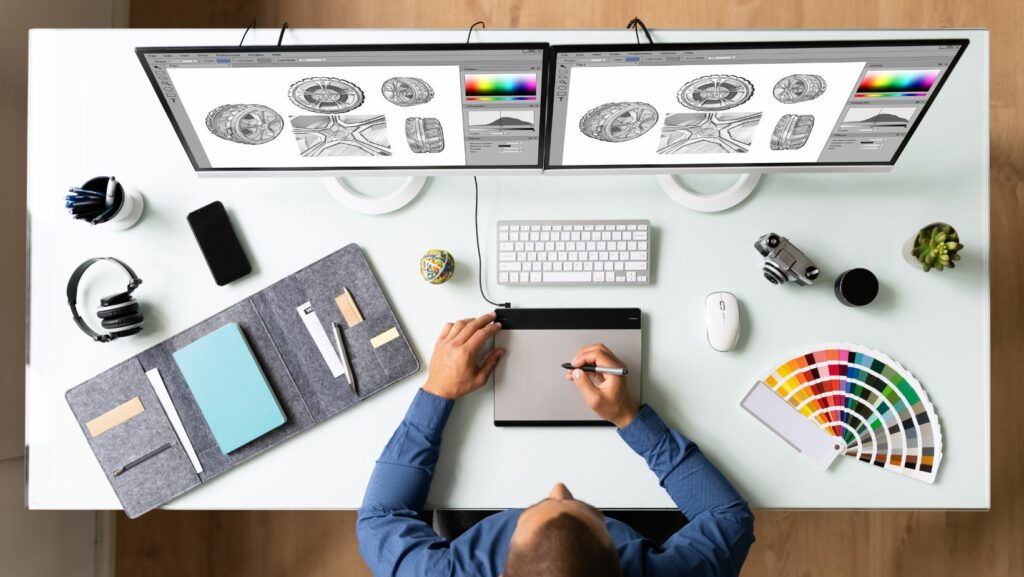When it comes to captivating digital experiences, web design play a pivotal role in shaping the online world we interact with daily. From eye-catching visuals to seamless user interfaces, the fusion of creativity and functionality is what sets exceptional designs apart. Whether it’s a striking logo that instantly resonates with a brand’s identity or a website layout that guides users effortlessly through content, the artistry of web design is ever-evolving. As the digital sphere continues to expand, the role of graphic web design remains at the forefront of creating engaging online experiences for audiences worldwide.
Graphic And Web Design
 Graphic design play a vital role in creating engaging digital experiences that seamlessly blend creativity and functionality. Designers need to grasp user preferences, technological advancements, and aesthetic trends to craft exceptional logos and user-friendly website layouts.
Graphic design play a vital role in creating engaging digital experiences that seamlessly blend creativity and functionality. Designers need to grasp user preferences, technological advancements, and aesthetic trends to craft exceptional logos and user-friendly website layouts.
- Typography Evolution – In the 15th century, Johannes Gutenberg’s invention of the printing press revolutionized typography, enabling mass production of written materials.
- Bauhaus Movement – The influential Bauhaus school in the early 20th century emphasized the fusion of art, craft, and technology, shaping modern graphic design principles.
- Digital Era – The advent of computers in the late 20th century brought about digital design tools, transforming the way designers create visual content.
These key milestones in graphic design history and trends in modern web design highlight the evolution and impact of design principles on creating captivating digital experiences.
Core Principles of Graphic Design
Graphic design play a crucial role in shaping immersive digital experiences that seamlessly blend innovation and practicality. Designers need to grasp user preferences, technological advancements, and aesthetic trends to craft compelling logos and intuitive website layouts while keeping the following core principles in mind.
Visual Hierarchy in Design
 Visual hierarchy in design is essential as it guides the viewer’s eye through a piece of content, allowing them to prioritize information intuitively. By strategically organizing elements based on size, color, contrast, and placement, designers can create a structured layout that directs attention effectively. For example, placing the most critical information in a larger font size or using contrasting colors for important elements can help users navigate and engage with the design seamlessly.
Visual hierarchy in design is essential as it guides the viewer’s eye through a piece of content, allowing them to prioritize information intuitively. By strategically organizing elements based on size, color, contrast, and placement, designers can create a structured layout that directs attention effectively. For example, placing the most critical information in a larger font size or using contrasting colors for important elements can help users navigate and engage with the design seamlessly.
Color theory is a fundamental aspect of design that influences user perception, emotions, and behavior. Understanding the psychology of colors and their impact on branding and user experience is vital for designers. By utilizing color harmonies, contrasts, and psychology principles, designers can evoke specific moods, highlight key elements, and create visual interest. For instance, warm colors like red and orange can stimulate energy and excitement, while cool colors like blue and green convey calmness and trust. By leveraging color theory effectively, designers can create captivating designs that resonate with the target audience and convey the intended message.
Current Challenges in Graphic and Web Development
 The constant evolution of web design brings forth various challenges that designers face in today’s digital landscape. Let’s delve into the key obstacles designers encounter and how they strive to overcome them.For instance, warm colors like red and orange can stimulate energy and excitement, while cool colors like blue and green convey calmness and trust. By leveraging color theory effectively, designers can create captivating designs that resonate with the target audience and convey the intended message.
The constant evolution of web design brings forth various challenges that designers face in today’s digital landscape. Let’s delve into the key obstacles designers encounter and how they strive to overcome them.For instance, warm colors like red and orange can stimulate energy and excitement, while cool colors like blue and green convey calmness and trust. By leveraging color theory effectively, designers can create captivating designs that resonate with the target audience and convey the intended message.
Designers often grapple with finding the perfect equilibrium between functionality and aesthetics in their creations. While aesthetics play a crucial role in captivating users, functionality ensures seamless user experiences. Striking the right balance between these two aspects is vital to create designs that not only look appealing but also perform intuitively and efficiently.
One of the significant challenges in graphic and web development is ensuring accessibility for all users. Designers must cater to individuals with disabilities by incorporating features that make digital content accessible to everyone. This includes using proper alt text for images, implementing keyboard navigation, and adhering to web accessibility standards. By prioritizing accessibility, designers can create inclusive designs that reach a broader audience and provide a better user experience for all.

